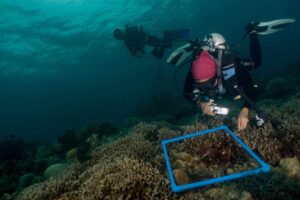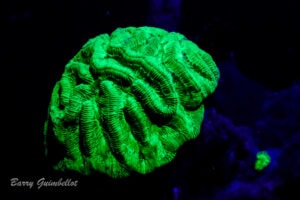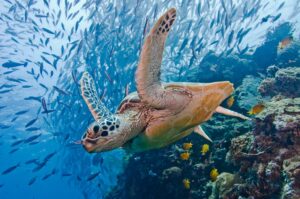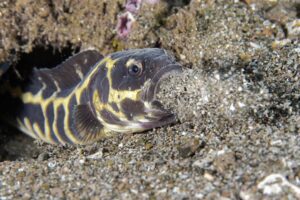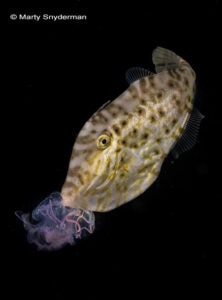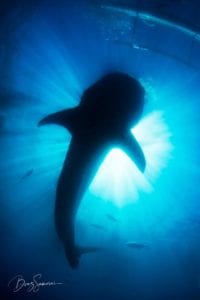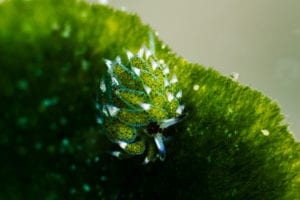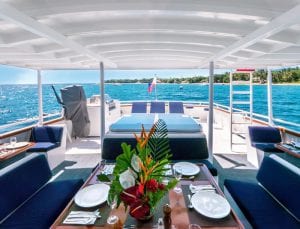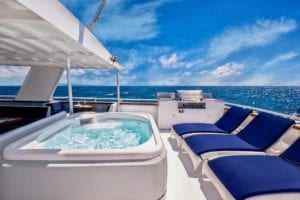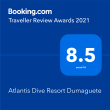[vc_row full_width=”stretch_row” bg_style=”stretch” css=”.vc_custom_1497424627607{padding-top: 20px !important;padding-bottom: 20px !important;}”][vc_column width=”2/3″ css=”.vc_custom_1501111104885{margin-bottom: 0px !important;padding-top: 30px !important;padding-right: 80px !important;padding-bottom: 30px !important;padding-left: 80px !important;background-color: #ffffff !important;border-radius: 5px !important;}”][vc_row_inner][vc_column_inner][vc_column_text]
Lucky Me! The Riches of the Coral Triangle
by Marty Snyderman
Every December for the past seven years I have served on an international panel of judges that selected the winning images in a rather prestigious photo contest. And every year when the organizer reviews the categories and rules with the judges before we see the entries, he says something along the lines of “let’s look for those special shots, something like a female mantis shrimp with a clutch of bight red eggs”.
I don’t think you will get much argument from underwater photographers about an image like that being out of the ordinary. I’ll confess, as of last year’s contest you would not have been able to find it in my photographic library.
But, now I can say “lucky me!” This past April at Atlantis Dumaguete I got my chance. Better yet, that moment was just one of many highlights during my two-week trip to Atlantis Puerto Galera and Dumaguete.
[/vc_column_text][/vc_column_inner][/vc_row_inner][/vc_column][vc_column width=”1/3″][vcex_image_grid columns=”1″ img_crop=”left-top” title=”no” image_ids=”9541″ img_width=”500″][/vc_column][/vc_row][vc_row full_width=”stretch_row” bg_style=”stretch” css=”.vc_custom_1497424627607{padding-top: 20px !important;padding-bottom: 20px !important;}”][vc_column width=”1/3″][vcex_image_grid columns=”1″ img_crop=”left-top” title=”no” image_ids=”9542″ img_width=”500″ img_height=”900″][/vc_column][vc_column width=”2/3″ css=”.vc_custom_1501111104885{margin-bottom: 0px !important;padding-top: 30px !important;padding-right: 80px !important;padding-bottom: 30px !important;padding-left: 80px !important;background-color: #ffffff !important;border-radius: 5px !important;}”][vc_row_inner][vc_column_inner][vc_column_text]
The Riches of the Coral Triangle
The region known as the Coral Triangle encompasses the roughly triangle-shaped area in the tropical Western Pacific that is bounded by the Indonesia, Malaysia, Papua New Guinea, Philippines, Solomon Islands and Timor-Liste. The bounties of the Coral Triangle have caused it to be recognized by the scientific community as the geographical center of marine biodiversity. Although the Coral Triangle includes less than 2% of the world’s oceans, it contains approximately 76% of all known species of corals and 37% of the world’s fish species. The more than 3,000 species of fishes that occur in the Coral Triangle give the region the highest diversity of coral reef fishes in the world.
The aforementioned is a brief scientific description. A diver might describe the Coral Triangle a “bucket list, must do”. The good news for all of us is that Puerto Galera and Dumaguete are well positioned within the Coral Triangle. So are the reefs of Tubbataha where the Atlantis liveaboard takes its guests.
[/vc_column_text][/vc_column_inner][/vc_row_inner][/vc_column][/vc_row][vc_row full_width=”stretch_row” bg_style=”stretch” css=”.vc_custom_1497424627607{padding-top: 20px !important;padding-bottom: 20px !important;}”][vc_column css=”.vc_custom_1501111104885{margin-bottom: 0px !important;padding-top: 30px !important;padding-right: 80px !important;padding-bottom: 30px !important;padding-left: 80px !important;background-color: #ffffff !important;border-radius: 5px !important;}”][vc_row_inner][vc_column_inner][vc_column_text]
Puerto Galera Rocks!
Our diving began in Puerto Galera where the highlights included encounters with weedy scorpionfish, an eye-catching Spanish dancer nudibranch accompanied by an emperor shrimp, stargazers, snake eels, ornate ghostpipefish, moray eels, bigfin reef squid, more nudibranchs than we could keep track of, and a three-dive day trip to the coral gardens and drop-offs of the nearby jewel named Verde Island. For macro photographers, Puerto Galera, or PG as many divers refer to it, is as close to a sure thing in terms of having wonderful opportunities to photograph macro subjects as you can find anywhere in the world.
My first “score” was a bright red weedy scorpionfish. We encountered it in about 65 feet of water after taking a boat ride that lasted less than five minutes. A bottom dwelling, slow moving, cryptic fish that attains a maximum length of just under 10 inches, the weedy scorpionfish occurs in colors that vary from bright red, pink, purple and yellow to brown, dark green, or almost black. The distinctive shape of its head, upturned mouth, and skin flaps that adorn much of the body and snout makes the weedy scorpionfish standout in the world of fishes as far as many camera-carrying divers are concerned.
Weedy Scorpionfish are ambush predators that quickly suck down an unsuspecting mix of fishes and invertebrates such as shrimp and octopuses. Despite their often-bright colors and unusual appearance, weedy scorpionfish blend in well with their surroundings, thus making any encounter “special”.
[/vc_column_text][/vc_column_inner][/vc_row_inner][vcex_image_grid columns=”2″ title=”no” image_ids=”9537,9526″ img_width=”500″ img_height=”500″][/vc_column][/vc_row][vc_row full_width=”stretch_row” bg_style=”stretch” css=”.vc_custom_1497424627607{padding-top: 20px !important;padding-bottom: 20px !important;}”][vc_column css=”.vc_custom_1501111104885{margin-bottom: 0px !important;padding-top: 30px !important;padding-right: 80px !important;padding-bottom: 30px !important;padding-left: 80px !important;background-color: #ffffff !important;border-radius: 5px !important;}”][vc_row_inner][vc_column_inner][vc_column_text]
Dumaguete
While many of the animals that are regularly encountered in Dumaguete are the same species as those seen in Puerto Galera, there are some notable differences due, at least in part, to the differences in the composition of the sea floor in the two areas. Generally speaking, the sea floor in Puerto Galera consists of coarse whitish sand. In Dumaguete the bottom is darker, siltier sand. As a result of these differences along with some other factors, some animals are more likely to be encountered in one area or the other.
As previously noted, we spent the second week of our trip exploring the waters off Dumaguete where we enjoyed another fantastic mix of subject matter for our cameras. Highlights included so many giant, painted, hairy, and warty frogfishes that it was difficult to keep count, green sea turtles feeding in the shallows, watching flamboyant cuttlefish do their thing, jacks feeding with white-spotted puffers, and hatching cuttlefish.
Two especially memorable experiences centered around ever-fascinating cuttlefishes. On the second dive of our day trip to nearby Apo Island, David Fleetham, Tim Rock and I came across a female pharaoh cuttlefish that was planting her eggs in the branches of a coral tree. We took turns photographing the action as the color-changing cephalopod planted an egg and retreated to nearby cover before repeating the process at least a dozen times.
The egg laying was a wonderful scene to witness, and things got even better the following day when we found another patch of eggs near the Dumaguete House Reef where some cuttlefish were hatching. I thought those dives could not be equalled, but that was before the dive Annie Crawley, David, Tim and I made with the female peacock mantis shrimp. I think it is best to enjoy dives, not compare them. That seems to be an impossible task in Puerto Galera and Dumaguete.
But lucky me! Like some of the other Atlantis ImageMakers, many of whom had not dived Puerto Galera and Dumaguete before, I plan to go back to both Atlantis resorts in the coming year for extended stays. I hope to see you there!
[/vc_column_text][/vc_column_inner][/vc_row_inner][vcex_image_grid columns=”2″ title=”no” image_ids=”9539,9540″ img_width=”500″ img_height=”500″][/vc_column][/vc_row]


